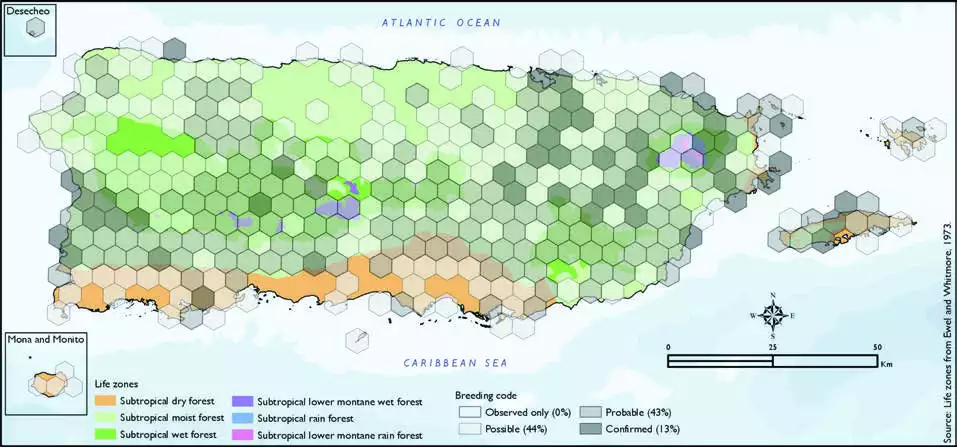Pearly-eyed Thrasher
Description
The pearly-eyed thrasher (Margarops fuscatus) is a bird in the thrasher family Mimidae. It is found on many Caribbean islands, from the Bahamas in the north to the Grenadines in the south, with an isolated population on Bonaire. At least two subspecies can be distinguished genetically: Margarops fuscatus fuscatus which is found between the Greater Antilles and Antigua and Barbuda, M. f. densirostris, occurring from Montserrat and Guadeloupe southwards. Its main habitat is bushes and trees in mountain forests and coffee plantations.
Distribution & Habitat
The Pearly-eyed Thrasher is a widespread species throughout
the West Indies (Arendt 2006,
Raffaele and others 1998). In
Puerto Rico, it is a common
resident throughout Puerto Rico
(Arendt 2006, Raffaele and others
1998, Recher and Recher 1966),
Mona (Biaggi 1997, Terborgh and
Faaborg 1973), Vieques (Gemmill
2015, Saliva 1994, Wetmore
1916), and Culebra (Wetmore
1917). This species is commonly
found in trees and bushes in
gardens, coffee plantations,
mountain forests (Oberle 2018),
thickets, woodlands, mangroves,
coastal palm groves, mountain
tops, urban areas, and forested areas at all elevations (Raffaele
and others 1998). The atlas
fieldwork yielded a total of 781
records within 370 hexagons
or 77 percent of the 479 total
hexagons (see map). Of the 370
hexagons where this species
was found, breeding met the
atlas definition of confirmed in
13 percent (49) of the hexagons,
probable in 43 percent (158),
and possible in 44 percent (163)
(see map). Pearly-eyed Thrasher distribution. The map shows the highest breeding code by hexagon and overlaying the ecological life zones in
Puerto Rico. Note: percentages may not total 100 due to rounding.

Breeding Habits
The Pearly-eyed Thrasher builds a bulky nest made of twigs,
sticks, dried grasses, and roots
(Arendt 2006, Biaggi 1997,
Raffaele and others 1998). The 229Pearly-eyed Thrasher/Zorzal Pardothrasher is a predator of eggs and nestlings of many small bird
species. It is known to compete
with Puerto Rican Parrots for nest
cavities and will destroy parrot
eggs and kill parrot nestlings
(Snyder and others 1987).
Previously published reports
indicate that it breeds from
December to September, and
the nests are usually constructed
in a cavity, though occasionally
open nests are placed in a bush
or tree (Arendt 2004, Raffaele
and others 1998), as well as
on or in buildings (Snyder and
others 1987). However, on
Mona Island, nests have been
found inside caves and in deep
crevices on the cliffs (Barnés 1946). Atlas results show that
this species breeding season
extends throughout the year with
the most breeding activity from
March to June (see chart). The
breeding activity peaks in June,
and the overall breeding pattern
mostly takes place within the
subtropical moist forest life zone
(see chart). Atlas results show
that this species breeds mostly
within the subtropical moist
forest life zone (59 percent of the
hexagons) throughout the island.
It also breeds in the subtropical
dry (20 percent of the hexagons)
and subtropical wet and lower
montane wet forest life zones (21
percent of the hexagons) (see
table and map).
Conservation
The global population size of the Pearly-eyed Thrasher has
not been quantified or assessed,
but it is described as common
(Stotz and others 1996). This
species is currently listed as a
species of least concern by the
IUCN (BirdLife International 2016). Locally, this species is not listed in any of the threatened categories of PRDNER and
USFWS. In Puerto Rico, the
Pearly-eyed Thrasher has a
protected habitat in land of 12
percent or 1041 km2 of the total area covered by the hexagons
where evidence of breeding
was found for this species
(8824 km2).
Related Species
Family:
mimid